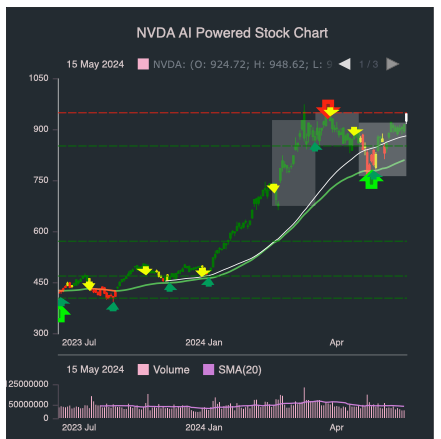To make sure you're making use of a platform that is capable of providing accurate and reliable forecasts and insights It is crucial to evaluate the accuracy and effectiveness of AI platform for predicting stocks and analyzing them. Here are 10 top suggestions to help you assess these platforms.
1. Backtesting Results
What to look out for Make sure the software allows backtesting. This allows you to evaluate the accuracy of your predictions based on historic data.
Why It Matters: Backtesting helps validate the AI model's accuracy by comparing its predictions with actual outcomes from the past.
Find platforms that provide the ability to set up backtesting parameters.
2. Real-time Performance Tracking
What to Look Out For What happens to the platform in real-time situations.
Why it matters It is because the platform's real-time performance is a better indicator of its performance rather than relying on only historical backtesting.
Try a trial for free or demo account to track and compare real-time predictions to the actual market movements.
3. Prediction Error Metrics
What to Look For Analyze metrics like Mean Absolute Error (MAE) or the Root Mean Squared Error (RMSE), or R-squared, to measure the accuracy of your predictions.
Why It Matters: These metrics give a measure of how close the predictions are to the actual results.
Tip: Platforms which openly reveal their metrics are more transparent and reliable.
4. The rate of success and winning ratio
What to Look Out For: Check for the platform's success rate (percentage that is based on accurate predictions) and its success rate.
What is important Why it matters: High success rates and win rates suggest better precision in forecasting and a greater potential for profitability.
It is important to be cautious about platforms that make false claims (e.g., 90% %+),) in the sense that no system will guarantee success.
5. Benchmarking against Market Indices
What to look for: Compare the platform's predictions and performance against the major market indexes (e.g., S&P 500, NASDAQ).
What it does It determines whether the platform is performing better or worse than the entire market.
Look for consistency in performance, not only gains over a short amount of time.
6. Congruity in Market Conditions
What to look out for: Examine how the platform performs under different market conditions.
The reason it's important A solid platform can perform effectively in all markets, not just those that have favorable conditions.
Tip: Try the platform during times of volatility or when the market is in a downturn.
7. Transparency in Methodology
What to look for What to Look for: Learn AI algorithms and models (e.g. neural nets, reinforcement learning).
Why is it important Transparency allows you to evaluate the validity and reliability of scientific research.
Tip: Avoid platforms that employ "black box" models without describing how predictions are generated.
8. User Reviews and Tests by Independent Parties
What to look for: Read reviews from users and check for independent testing.
What's important Reviews, tests and assessments provide objective and unbiased information on the performance and accuracy of the platform.
Tip: To find out what users think, check forums such as Reddit copyright as well as financial blogs.
9. Risk-Adjusted Returns
What to Look For What to Look For: Assess the platform's performance by using risk-adjusted metrics like the Sharpe Ratio or Sortino Ratio.
Why it is Important The metrics are based on the level at which risk is taken in order to earn returns. This gives the most complete image of performance.
Sharpe Ratio: If extremely high (e.g. greater than 1), this indicates higher returns when risk is taken into account.
10. Long-term track records
What to Look for How to evaluate the performance of the platform over a period of time (e.g. 3-5 years).
Why It Matters : Long-term performances are more reliable than results in the short-term.
Do not use platforms that only showcase the smallest of successes or cherry-picked results.
Bonus Tip: Test your account using an online version
You can check out predictions on the platform in real-time without risking any money by using a free trial account or demo account. This lets you test the accuracy and effectiveness of the system on your own.
With these suggestions, you can evaluate the accuracy as well as efficiency of AI platforms for stock analysis and prediction. Choose one that is in line with your needs for trading and the risk you are willing to take. Be aware that there is no perfect trading platform, and the best strategy is to blend AI insight with your own personal research. Take a look at the most popular ai trade tips for more advice including chatgpt copyright, ai investing app, ai for investing, ai for investment, ai for stock trading, ai for stock trading, best ai stock, ai investing app, ai stock picker, market ai and more.

Top 10 Ways To Assess The Speed And Latency Ai Analysis And Stock Prediction Platform
Latency and speed are crucial when it comes to considering AI stock prediction/analyzing trading platforms. This is particularly true for algorithmic traders, high-frequency traders, as well as active traders. A delay of just milliseconds can be detrimental to the execution of trades. Here are 10 top tips for measuring the speed of your platform.
1. Real-time Data Feeds to be used for evaluation
Speed of data delivery: Make sure the platform provides real-time data with minimal delay (e.g. less than a millisecond delay).
Closeness of the data source: Find out if servers are located near major exchanges.
Data compression - Verify that the platform is using effective data compression techniques to increase data delivery speed.
2. Speed of execution test for trades
Time to process orders: Determine how fast the platform handles and executes trades when you submit an order.
Direct Market Access: Verify that the platform provides DMA. DMA is a feature that lets you transmit orders directly to exchanges without intermediaries.
Execution reports. Make sure the platform has comprehensive execution reports. These reports must include timestamps for order submission, confirmation and fill.
3. Assess Platform Responsiveness
Speed of the user interface (UI) Find out how quickly the user interface of the platform responds to your inputs.
Chart updates: Check to see if the charts and visualizations are updated in real time without lag.
Performance of mobile apps If you are using a mobile app make sure it runs as quickly as the desktop version.
4. Verify that the infrastructure is low-latency.
Server Locations: Make sure that the platform has servers that are low-latency and located near major hubs for financial exchanges or financial hubs.
Co-location services: Find out whether your platform has this option. This allows you to host trading algorithm on servers located near to the exchange.
High-speed Networks: Verify the application's use of a fiber-optic high-speed network, or other technology with low latency.
5. Test the backtesting and simulation speed
Test the platform's capacity to process and analyze the historical data.
Latency in simulation: Make sure the platform can simulate trades without noticeable delays.
Parallel processing (or distributed computing) Learn if a platform uses the concept of parallel processing or distributed processing in order to accelerate complicated calculations.
6. Estimate API Latency
API response: The API's API is measured by the amount of time it takes to respond to requests.
Rate limits. Check to see if there are reasonable limits for the API. This will aid in preventing delays during high-frequency transactions.
WebSocket Find out if your platform is compatible with WebSocket protocols that allow streaming data in real time with low latency.
7. Test the stability of your platform using Load
Simulation of scenarios involving high volume trading to see whether the platform is reliable and stable.
Market volatility: Make sure the platform can handle price fluctuations during times of high volatility.
Stress testing: Check if the platform offers the tools to stress test your strategies under extreme circumstances.
8. Assess Network and Connectivity
Internet speed requirement: To achieve optimal performance, ensure that your internet speed is in line with the speed of your preferred platform.
Redundant connections: Check if the platform has redundant internet connections to prevent interruptions.
VPN latency: When using the VPN platform, check if the latency is significant and also if there are alternative options.
9. Make sure you are using Speed Optimization features.
Pre-trade Analytics: Ensure that the platform provides pre-trade analysis to improve order routing, execution speed and many other aspects.
Smart order routing (SOR): Verify that the platform is using SOR to find the fastest and most cost-effective execution sites.
Latency monitoring: Determine if your platform has tools that let you analyze and monitor latency real-time.
Review User Feedback & Benchmarks
User reviews: Read the feedback of users to assess the platform’s performance on latency and speed.
Third-party benchmarks from third-party. You can find benchmarks from independent sources or reviews that evaluate a platform's speed with other platforms.
Case studies: See whether the platform has case studies or testimonials highlighting the platform's low-latency capabilities.
Bonus Tips
Free trial period: Try the platform's performance and latency in real-world scenarios using a demo or free trial.
Support for customer - Make sure there is support available to address issues relating to latency, optimization or other issues.
Hardware requirements: Determine if your platform requires a specific hardware requirement for maximum performance.
These suggestions will allow you assess the speed and latencies of AI platform for stock prediction and analysis. This way you can pick a platform that is suitable for your requirements while minimizing delays. A low latency is essential for high-frequency traders and algorithmic traders. Even small delays can have a significant impact on profitability. Check out the best best ai trading platform for website recommendations including best ai penny stocks, ai copyright signals, ai stock investing, investing with ai, stock trading ai, stock trading ai, investing with ai, ai options, best ai stocks to buy now, ai stock analysis and more.
